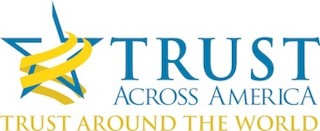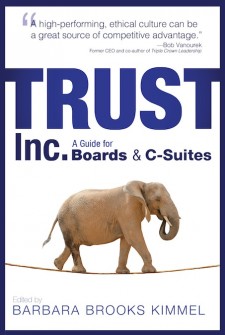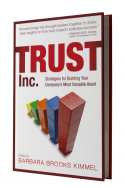Archive
Posts Tagged ‘transparency’

August is “Transparency” Month
according to Trust Across America’s
Merriam Webster defines “transparent” as visibility or accessibility of information, especially with business practices. A leader who thinks he or she can still hide behind a veil of secrecy need only spend a few minutes on social media reading what stakeholders are saying.
During the 52 weeks of 2014 you can build trust in your organization by thinking about, discussing and following the advice of the experts. Below are weekly reflections on trust for August 2014.
Week 1: It’s useful to think of trust and its payoffs on a continuum. Elsie Maio, Humanity Inc.
Week 2: Trust is the acceptance of risk, and thus gives the ability to foresee, acknowledge and understand that no one is perfect. Stephen Marsh, PhD, UOIT, Canada
Week 3: Long-term trust trumps short-term profits and public relations gimmicks. Timothy J. McClimon, American Express Foundation
Week 4: Self-organized teams (SOTs) require and reinforce trust. Deb Mills-Scofield, Innovanomics
Please share your comments and suggestions! Email: barbara@trustacrossamerica.com
Barbara Brooks Kimmel is the Executive Director of Trust Across America-Trust Around the World whose mission is to help organizations build trust. She is also the editor of the award winning TRUST INC. book series. In 2012 Barbara was named “One of 25 Women Changing the World” by Good Business International.
. 

Copyright © 2014, Next Decade, Inc.
Barbara Brooks Kimmel, barbara kimmel, Deb-Mills Scofield, leadership, organizational trust, transparency, trust, trust in business, Trust Inc. A Guide for Boards & C-Suites, Trust Inc. Strategies for Building Your Company's Most Valuable Asset

What stops companies from building a culture of authentic long-term trust? As transparency increases, so does the ability of every citizen to look behind the curtain, with the click of a Google search.
I’m not trying to win a popularity contest with this blog post, at least not with corporate America. But hey, ask most C-Suite folks about trust issues in their organization and they won’t hesitate to emphatically tell you they have not a single one.
Last week I attended an event featuring two guest speakers (also sponsors) from large global companies in different industries. At the end of their respective speeches everyone in the audience applauded loudly except for me, and one other attendee. The other attendee “gets” trust like very few others. Based on their professional credentials, it’s understandable. Think nurse or military leader.
What made these speeches so excruciatingly painful?
First the canned, compliance-approved content, and second, the cult-like focus on the corporate responsibility programs of both organizations. While Trust Across America’s FACTS® Framework shows us that no company is perfect, both of the sponsor firms have recently paid massive fines for, let’s (politely) say, ethics violations. Not the first fine for either, and probably not the last, and just a mere “blip” on the quarterly earnings radar. So whom are they kidding? Judging from the applause, the vast majority of the audience.
As transparency increases, so does the ability of every citizen to look behind the curtain, with the click of a Google search. All it takes is a few minutes and a curious mind. Corporate responsibility is an important component of a trustworthy organization but it’s only one component. I’m not suggesting that companies air their dirty laundry in public. What I am suggesting is that they stop using the corporate responsibility officer as a public relations pawn. It may work now, but it is a short-term, unsustainable strategy. When the next ethics “oops” occurs, it may be the one that brings down the house, and nobody is going to care about the organization’s philanthropic efforts.
What if the C-Suite were to lead with a culture of trust by creating a long-term trust-building strategy and sent their CR officer into the field to talk about that instead? What if they discussed the company’s values statement or corporate credo, and how it meets the needs of all their stakeholders? What’s stopping companies from building their culture around authentic long-term trust? Is it the legal department?
And finally, the cherry on the weekly “trust cake” is contained in this article in which the author suggests that telling the truth undermines trust.
Next week is the start of spring. It’s also my birthday. Maybe the cake will be a bit less stale. Maybe the most popular flavor will change from artificial vanilla-coating to trust.
For more information on building trust in your organization you can read our new book, Trust Inc., Strategies for Building Your Company’s Most Valuable Asset.
Barbara Brooks Kimmel, barbara kimmel, corporate responsibility, CSR, ethics, FACTS(R), integrity, leadership, organizational trust, transparency, trust, trust across america, trust in business, Trust Inc. Strategies for Building Your Company's Most Valuable Asset





Recent Comments